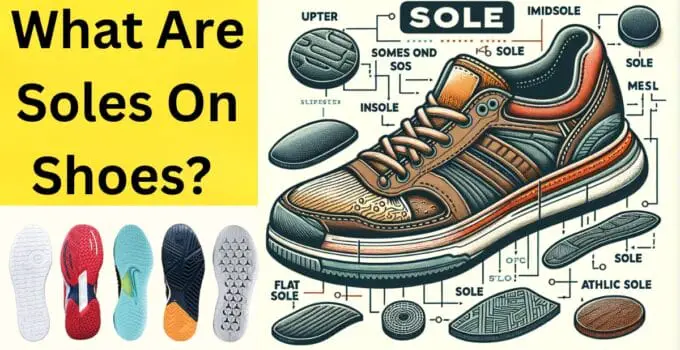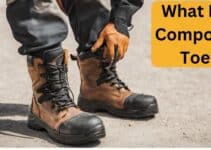Soles are a few of the most crucial components of a pair of footwear, yet they are often not noted. Usually crafted with durable importance, like leather-based or rubber, shoe soles protect your feet from the surface you are on or standing on. They additionally offer traction and assistance that will help you live consistently on your feet. This article aims to explain What Are Soles On Shoes, the styles of shoe sole materials, and their essential features.
What Are Soles On Shoes?
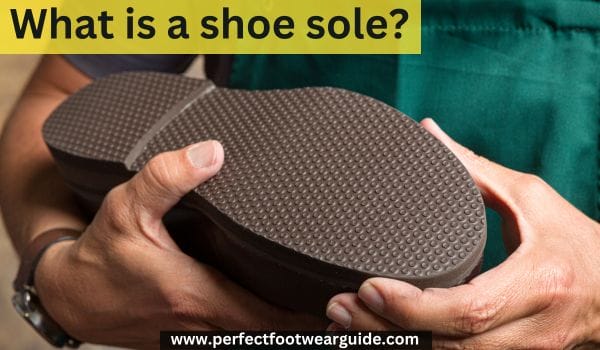
In simple terms, the bottom part of the shoe does all the ground-touching. It spans the entire underside of the shoe between the upper part and the heel section. Shoe soles can range in thickness depending on the type of shoe and are usually the widest part of the shoe profile.
Designed from rigid, resilient materials, shoe soles are designed to withstand regular abrasion from walking, running, or other activities. Their primary roles include:
Providing a protective barrier between your feet and potentially harsh or hazardous surfaces. Shoe soles guard against debris, moisture, temperature extremes, and impacts.
Grip and traction to keep you stable on your feet. Textures and patterns on shoe sole bottoms enhance friction for better grip on different surfaces and terrains.
Absorbing shock and impact from foot strikes during activities to safeguard your feet and lower limbs. Cushioning shoe soles disperse forces of impact.
Adding structure, support, and stability to your arches and insteps. Rigid sole designs reinforce the shoe shape for comfort and balance.
Popular shoe sole materials
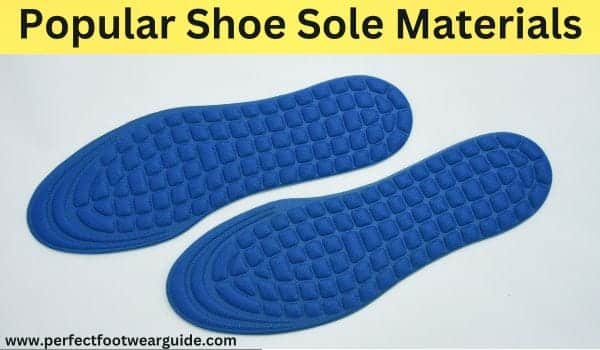
There are several materials commonly used in shoe sole construction based on the shoe type and intended usage:
Rubber: Durable and weatherproof, rubber soles are a top choice for versatile casual and athletic shoes. Textured tread designs boost grip while rubber absorbs shocks well.
Leather: Softer natural leather is breathable and molds to feet for comfort. Often paired with rubber or synthetic overlays for sturdiness. Popular for dress shoes.
Thermoplastic rubber (TPR) is synthetic and molds nicely for custom shaping and flex. Lightweight yet rigid TPR soles are commonly used for sandals.
Polyurethane (PU): Extremely durable synthetic for high-wear applications like work boots and soccer cleats. Provides excellent traction and padding.
Phylon: Phylon is a lightweight ethylene-vinyl acetate foam commonly used in running shoe midsoles and outsoles for springy cushioning.
Carbon fiber: Extremely rigid and robust yet ultralight material incorporated into high-performance racing shoes and cleats. Ideal for propulsion.
Vibram: The brand name for one of the original rubber outsole compounds featuring specialized rubber formulas and tread patterns for specific uses like hiking boots. Extremely tough and long-lasting.
Specific types of shoe soles
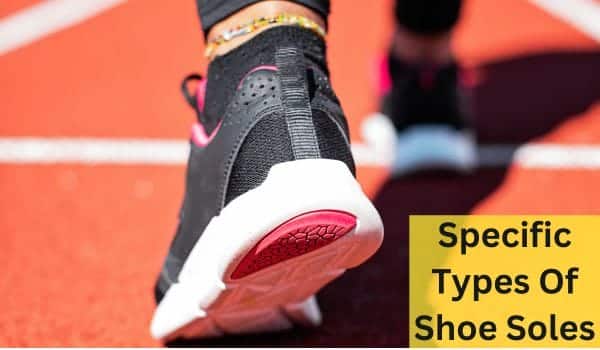
While shoe bottoms perform similar functions across categories, their constructions can differ considerably depending on the shoe type:
Running shoe soles:
Feature layered constructions with a firm midsole and more flexible outsole for propulsion. Shock-absorbent multilayered cushioning systems under the heel and forefoot aid explosive walking or running strides.
Tennis shoe soles:
- Employ tread patterns adapted for optimal traction on hard surfaces like courts.
- It may include herringbone or waffle designs.
- Include stabilizing elements and lateral support structures.
Hiking shoe soles:
Thick, multi-density Vibram rubber soles perform well on uneven terrain with deep treads. Provide protective toe caps for rugged trails.
Dress shoe soles:
Thinner leather or synthetic dress soles with minimal tread are designed for more refined footwear. Offer polished appearances suitable for work or formal occasions.
Sandals and flip-flops:
Ultra-slim rubber or thermoplastic outsoles are lightweight yet durable. Shaped for custom comfort with minimal coverage over the foot surface.
Work boot soles:
Constructed for rugged dependability under heavy loads and challenging conditions. Steel-tipped composite safety toe boots feature oil and slip-resistant soles.
Importance of proper sole selection
Choosing the suitable shoe sole material and design is essential depending on your activity needs and environmental conditions. Considerations include:
Surface traction is needed on wet, dry, or varied surfaces. Deep treads provide control in muddy or slippery areas.
Shock absorbency is based on high-impact activities like running versus low-impact walking. Support varies needs.
Support and stability needs for overpronation or neutral gaits in athletic shoes. Rigid or flex grooves affect motion control.
Lightweight or reinforced designs based on load carrying for work or hiking versus casual wear.
Weatherproof durability suits cold, hot, wet, or dry exposures over long periods.
Foot protection from environmental or workplace hazards like chemical resilience, slip resistance, or steel safety toes.
With so many shoe sole innovations, taking them for granted is easy. But like any shoe component, carefully selecting soles tailored to your specific usage helps optimize performance, comfort, and safety on your feet.
Additional shoe sole materials
While the most common shoe sole materials were covered above, here are some other exciting options:
EVA: Ethylene-vinyl acetate foam, known as phylon, is exceptionally lightweight yet resilient. It provides cushioning properties suitable for shoe midsoles.
Poron: A urethane-based synthetic designed to be shock-absorbing, durable, and moisture-wicking. Used in specialty insoles and inserts.
Bamboo: Naturally moisture-wicking and antibacterial bamboo fibers are incorporated into eco-friendly shoe components, including shoe soles.
Cork: Sustainable natural material yielding lightweight yet sturdy properties. Breathable cork shoe soles are comfortable and odor-resistant.
Specialized shoe sole technologies: Manufacturers leverage advanced technologies to develop enhanced shoe sole designs for modern footwear needs. Here’s a closer look at some innovative sole technologies:
Carbon fiber plates: Ultra-light rigid inserts integrated into shoe midsoles boost propulsion and improve running economy. Popular in racing shoes.
Podular constructions: Clustered high-density foam pods under strategic foot zones individually compress for tailored cushioning.
Split-sole designs: Separate midsole components on the inner and outer shoe sides allow independent flexibility or rigidity for stability benefits.
Rolling sole arcs: Curved sole profiles mimic the natural rocking cadence of barefoot locomotion, improving gait efficiency.
Air cushioning systems: Chambers of pressurized air dispersed in midsoles are continuously shaped into feet for plush comfort over long distances.
Magnetic resonance imaging (MRI): Scanning impact forces and movements to engineer cushioning zones offers precise targeted protection.
3D printed soles: Bespoke personalized shoe components are constructed using foot scans and pressure mapping for optimal custom fit.
Kinetic feedback systems: Springs, masses, and sensors feed motion data to microprocessors, dynamically adjusting real-time cushioning and midsole firmness.
Shoe sole maintenance:
It is recommended that shoe soles be cared for and maintained correctly to maximize their performance and lifespan:
- Inspect and clean outsole treads regularly to remove debris that accelerates wear.
- Protect soles from unnecessary abrasion by removing shoes in entryways to preserve traction lugs.
- Periodically apply a protective dressing or barrier cream like Proofide to waterproof leather soles to prolong life.
- Replace shoe soles promptly if worn, as continued use can damage other materials like uppers.
- Apply rubber or dressing renewers containing conditioners and solids to restore elasticity to dried soles as needed.
- Avoid walking on hot asphalt, which softens rubber and causes premature wear without allowing time to cure fully.
What is the primary material used for shoe soles?
The two most common materials used for shoe soles are rubber and leather. Rubber is very durable and provides good traction, making it ideal for many athletic and casual shoes. Leather offers breathability and flexibility and is often used for dress shoes and boots. Synthetic materials like thermoplastic polyurethane are also widely used nowadays.
How thick should a shoe sole be?
Each correct thickness should be determined depending on the shoe’s purpose and design. Athletic shoes tend to have thicker soles (around 1/2 inch) for cushioning and stability. Dress shoes are much thinner, around 1/4 inch, for a slim profile. Work boots may be 3/4 inch or more for durability and protective toe caps.
How does the sole material affect performance?
The material dramatically impacts performance. Rubber excels on wet or uneven surfaces but can get hot. Leather molds to feet but offers less traction. Dense foams like EVA cushion shock well, while lightweight foams propel motion. Carbon fiber soles dish out instant energy return. Choosing the right blend maximizes comfort and function.
What things can cause shoe soles to wear out faster?
Some factors that accelerate sole wear include walking long distances regularly, running or high-impact activities, improper gait mechanics like overpronation, wearing shoes too large that allow sliding, playing sports outside like soccer or baseball, wearing shoes in wet or harsh conditions without protection, and inadequate care like failing to clean out dirt and debris.
How can I prolong the life of shoe soles?
Here are some tips: regularly clean outsoles, apply protective dressings to leather soles, replace worn shoes promptly, avoid extreme heat exposure, properly support arches and feet, rotate multiple pairs of shoes, inspect for proper fit and support, and have worn pairs resoled by a cobbler when possible instead of entirely replacing shoes.
Conclusion
What Are Soles On Shoes? High-quality shoe soles are integral to footwear construction, whether you need durable traction for intense activities or everyday protection under casual wear. With a dedicated focus on health, safety, and performance, manufacturers continuously innovate sole materials and designs tailored to evolving needs. You can gain the support and longevity your feet deserve by selecting shoes with soles engineered for your requirements and proper care.
